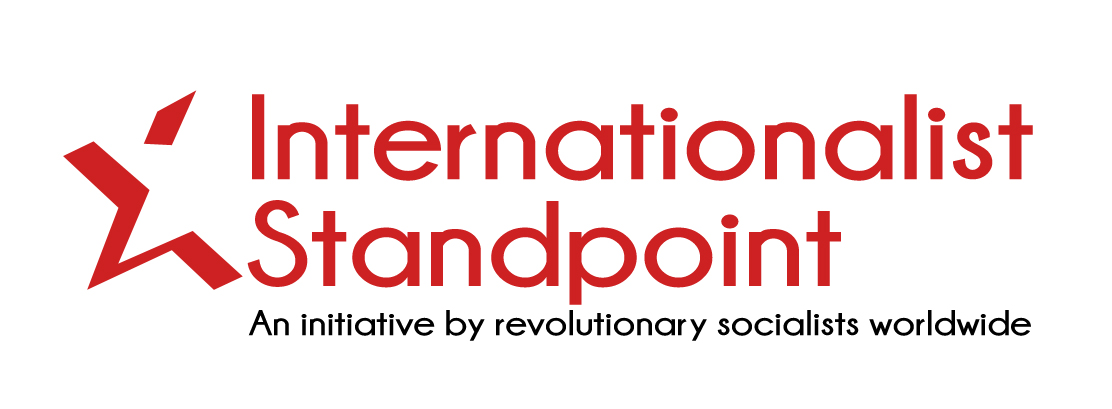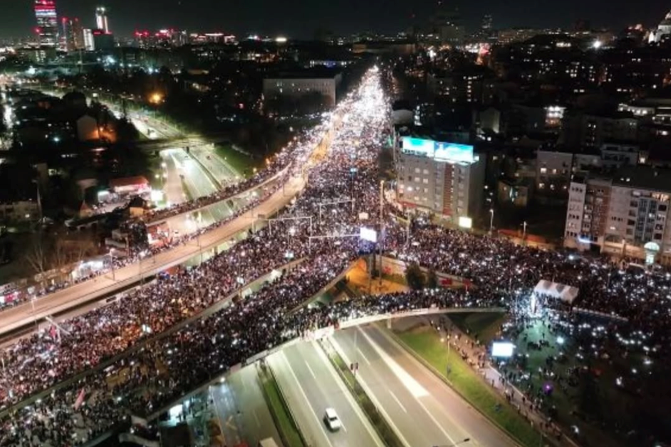Over the past three months, Serbia has witnessed a continuous student movement, which has already led to the resignation of the Prime Minister. There were mass demonstrations which culminated at the end of January in a general strike, road blockades and massive demos.
On the surface, this movement appears to be a struggle for the “rule of law”. But if we go deeper in analysing its root causes, it has revealed the inherent contradictions of capitalism in Serbia. Although expressed in this way, it is not simply a demand for abstract principles of justice, but an expression of discontent with the way the economy and politics are subservient to capital through the ruling class.
The symbolic collapse of capitalist infrastructure
The starting point of the protests was the collapse of the recently renovated railroad hub in Novi Sad, a tragedy that resulted in the loss of 15 lives. This event is not an accident, but the result of an economy in which infrastructure is built with a view not to serve social needs, but for the needs of Capital, which expresses itself through the profit generated by the class that represents it, the bourgeoisie.
Thus we end up with this disaster, which is expressed today by an economic model based on opaque subcontracting, political complicity and cost-cutting at the expense of the quality of certain products, in this case rail infrastructure. This economic model is being challenged by students and some of the workers who have already been protesting in Serbia for 3 months. Students have been occupying the universities since December 2nd.
This is not an isolated situation, but a manifestation of a widespread trend of collapse in infrastructure in capitalist countries worldwide. But what are the protesters’ demands?
The demands of the movement
- Respect the rule of law: A central demand is the fair and impartial application of laws, free from political influence or corruption.
- Transparency and accountability: publish all documents related to the refurbishment of Novi Sad station and thoroughly investigate the causes of the collapse.
- Resignation of the officials involved: Although Prime Minister Milos Vucevic and other ministers and mayors have resigned, protesters are also demanding the resignations of other politicians held responsible for corruption and negligence.
- Release arrested students: Call for the release of colleagues detained during the demonstrations and the dropping of charges against them.
- Increasing the education budget: In the document written by students, they emphasize that a required minimum of 1% of GDP, instead of 0.8% must go to higher education
The students close the document with the phrase “we ask for the institutions of the system to do their job in accordance with the law and in the interest of all citizens”.
As we can see, these are demands that a lot of people would expect are realisable within the framework of bourgeois society as they do not go beyond its logic. Let us see why and what possibilities exist for these mass movements to take a revolutionary path.
How did the authorities and society react?
- Resignations and promises: The Prime Minister’s resignation and promises of transparency, including the publication of documents related to the station renovation, as demanded by the students in their demands. Of course, the resignation came after the 24hour protest/strike
- Repressive actions: arrests of students and accusations of violence against protesters, which amplified discontent. One student was run over by a car during the protests, leading to bigger protests.
- Public support: Various segments of society, including taxi drivers and university professors, expressed their solidarity with the students, offering logistical and moral support.
The role of the Students
The student-led protests have not yet developed a clear understanding of how workers are affected by the same systemic “corruption”. Students are challenging a state that breaks the rule of law, but they have not yet questioned its very capitalist nature. The protests thus remain within a sphere of democratic demands, without identifying exploitation as the fundamental problem.
This limited orientation can be partly explained by the very social nature of the students: they do not form a distinct economic class, and their demands are not yet directly linked to the material conditions of production. A second factor is the drawing back of consciousness in recent decades, especially in the former Eastern Bloc countries, where socialist and communist solutions have been discredited by the previous regimes that spoke in their name.
What could potentially change the situation and broaden the demands of the movement is the entrance of the working class in the movement. Some steps have been taken in this direction on the day the movement called for a ‘general strike’ (to our understanding, there was not a general strike called by the union tops, but some unions and workplaces took strike action or closed down). The resignation of the Prime Minister was connected to the fear of workers moving into the arena of struggle.
Workers could connect the demands of the movement against corruption to the general structure of the capitalist system, meaning they would articulate their own demands.. In this case, the role of workers will be crucial: only they, as a class defined by their position in the system of production, have the power to destabilize capitalism and transform discontent into revolutionary action.
Workers have a crucial role to play
Workers from various sectors have started to join the protest, but not yet in an organized way. Taxi drivers in Belgrade offered free transportation to the protesters and university professors supported the movement. Organized unions, especially in the big sectors, however, did not show solidarity with the mass protests and did not initiate or announce any strikes (at least not collectively). Only postal workers and teachers expressed solidarity with the students, teachers also taking strike action.
This showcases that we are still in a period of defensiveness of the working class, and this comes from several reasons that feed on each other: the lack of a sizable class party of the workers, through which the working class can advance its interests, the loss of relevance of the trade unions and their guild attitude that leads to struggles by sectors and not as a class, the way production works today, more atomized than in the past, ect.
Perhaps more than ever there is a need for a mass workers party (as a form organization, part of a whole, in this case part of the working class) of the more advanced, class-conscious layers. Such a party can intervene in the struggles led by the workers in order to propose a way forward, transforming those struggles from limited ones into ones that are aimed at workers as a class and have a generalised emancipatory potential.
For these protests to gain real strength, workers must first of all be involved. Workers can recognize themselves as a class only through class struggle. If they take on this role, their struggle will have the potential not to be limited to demands against corruption, but will tend to become a process of challenging the relations of production.
For “accidents” like this to never happen again, there needs to be a socialist transformation of society (although true socialism will be miles away in terms of workers democracy from the experience of Stalinism that Serbian workers have). For this to happen, workers should not only be a supporting element for student protests – they should become the driving force of social struggle, because only they are capable of blocking the production process, gaining political strength and attacking the interests of capital at its foundations. Although there are signs of solidarity, they are not yet strong enough to turn these protests into a mass movement capable of changing the structure of society.
The struggle must be international
These protests should not be seen in isolation, but in a global context. The working class is being exploited and killed in what the bourgeoisie calls “our homeland”. The problems of workers and students in Serbia are very similar to those of workers in France, Spain, Germany or even Latin America, Asia, etc. That’s why the struggle against exploitation must be international.
It is therefore essential that protest movements transcend national borders and form international solidarity. The struggle against capitalism cannot be waged only in one country, as the global bourgeoisie operates on a transnational level. Any local victory will be temporary and subject to recuperation by the system if such a struggle does not spread at least in a larger region and then all over the world.
To this end, students and workers in Serbia should seek support and build alliances with other protest movements in the region and in Europe. Part of the movement has the illusion that the EU is a democratic entity that would solve many of these problems, in reality the European Union is not a guarantee of social rights, but a mechanism which perpetuates the interests of capital. Only an international workers’ movement can truly change society.
The students’ struggle is important, but without an organized workers’ movement, any change will be limited and recuperated by the system. If workers rise up, they will not only demand reforms, they could question the very structure of society. And this possibility must be at the center of any analysis of the future of the protests in Serbia and everywhere else in the world.
*A militant from the movement provided us with information that was very much needed in this article and we want to thank them with this line.



